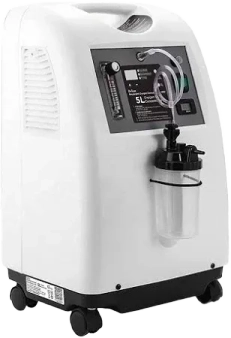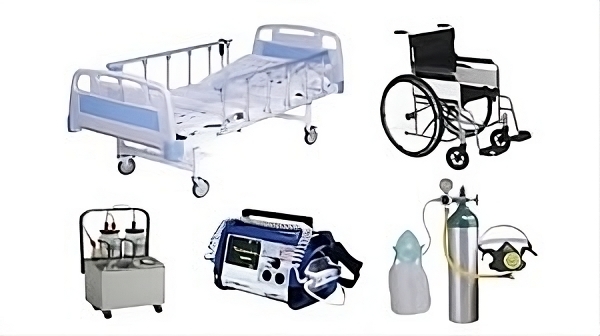Our highest rented or buying products.

Introduction For individuals with respiratory conditions such as COPD, pneumonia, or severe asthma, oxygen therapy can be life-changing. Oxygen concentrators offer a convenient and reliable way to supply supplemental oxygen at home, making it easier for patients to breathe and stay active. This guide explains how oxygen concentrators work, when they’re recommended, and how they compare to other oxygen therapy options. ________________________________________ 1. What is an Oxygen Concentrator? An oxygen concentrator is a medical device that delivers concentrated oxygen to patients who need extra respiratory support. Unlike oxygen tanks, which contain stored oxygen, an oxygen concentrator pulls in ambient air, filters out nitrogen, and delivers purified oxygen through a mask or nasal cannula. • Key Components: The device uses a compressor, sieve bed filter, and pressure valves to separate oxygen from the air. Concentrators are typically compact, making them suitable for home use. Oxygen concentrators are recommended by healthcare providers when a patient needs consistent oxygen support to maintain safe blood oxygen levels, and they can be used for both chronic and short-term conditions. ________________________________________ 2. How Does an Oxygen Concentrator Work? Oxygen concentrators operate on a simple yet effective process of filtering atmospheric air and delivering pure oxygen to the patient. Here’s a step-by-step breakdown of how they work: 1. Air Intake: The concentrator draws in air from the surroundings, which contains around 21% oxygen and 78% nitrogen, along with trace gases. 2. Compression and Filtration: The air is then compressed and sent through a filter system that separates nitrogen from oxygen. The filter, known as a sieve bed, traps nitrogen and allows oxygen to pass through. 3. Delivery of Purified Oxygen: The purified oxygen (usually 90–95% concentrated) is delivered through a tube, mask, or nasal cannula directly to the patient. This continuous process ensures a steady flow of oxygen, allowing the patient to receive support without the need for refilling tanks. ________________________________________ 3. When Do You Need an Oxygen Concentrator? Oxygen concentrators are prescribed for various respiratory conditions, including: • Chronic Obstructive Pulmonary Disease (COPD): Patients with COPD often have reduced lung function and need additional oxygen to maintain blood oxygen levels. • Severe Asthma: In some cases, severe asthma can cause significant drops in oxygen levels, making supplemental oxygen necessary. • Pneumonia and Post-Surgery Recovery: Oxygen concentrators can be used temporarily to aid recovery from respiratory infections like pneumonia or after surgeries that affect breathing. • Sleep Apnea and Hypoxia: Patients with obstructive sleep apnea or low blood oxygen levels (hypoxia) may benefit from nighttime oxygen therapy to improve sleep quality and overall health. Consult a healthcare professional if you’re experiencing symptoms such as shortness of breath, fatigue, or difficulty breathing. They can perform an oxygen level test and determine if an oxygen concentrator is necessary. ________________________________________ 4. Types of Oxygen Concentrators There are two main types of oxygen concentrators: stationary and portable. Here’s a quick comparison: • Stationary Oxygen Concentrators: These models are designed for home use, often providing higher oxygen flow rates (up to 10 liters per minute). They are bulkier and require an electrical outlet, making them less suitable for travel but ideal for consistent, at-home therapy. • Portable Oxygen Concentrators (POCs): POCs are lightweight, battery-powered devices that allow patients to move freely while receiving oxygen therapy. They typically provide lower flow rates (up to 5 liters per minute) but offer flexibility for active individuals. POCs are approved by the FAA, so they can be used on flights. Selecting the right type depends on your lifestyle and the oxygen flow rate prescribed by your healthcare provider. ________________________________________ 5. Benefits of Using an Oxygen Concentrator Oxygen concentrators offer several advantages for patients in need of oxygen therapy: • Continuous Oxygen Supply: Unlike tanks that require refills, concentrators draw air from the surroundings, providing an endless supply of oxygen as long as they’re powered. • Cost-Effective: Oxygen concentrators are more affordable in the long run compared to regularly purchasing oxygen tanks. • Improved Quality of Life: Supplemental oxygen can improve sleep, increase stamina, and enhance overall well-being for patients with chronic respiratory issues. • Portability: For those who want to stay active, portable oxygen concentrators offer freedom and flexibility, making it easier to travel and enjoy daily activities. By choosing the right oxygen concentrator, patients can maintain their independence while ensuring they receive the respiratory support they need. ________________________________________ 6. Oxygen Concentrators vs. Oxygen Tanks While both devices provide oxygen therapy, they differ in key ways: • Oxygen Tanks: Tanks store a finite amount of compressed oxygen and must be refilled or replaced when empty. They don’t require electricity but are heavy, making them harder to transport. Tanks are often recommended for patients who need high flow rates temporarily. • Oxygen Concentrators: Concentrators don’t need refills and are powered electrically, making them suitable for continuous, long-term use. They’re generally lighter and more convenient for daily activities, though they may have lower flow rates than tanks. For long-term or home use, oxygen concentrators are typically more convenient and economical. However, tanks are useful for patients needing emergency or short-term oxygen at high flow rates. ________________________________________ Conclusion Oxygen concentrators are a versatile, cost-effective option for patients needing oxygen therapy at home or on the go. By understanding how these devices work and consulting with a healthcare provider, you can make an informed choice that improves both comfort and quality of life. Whether you opt for a stationary model for home use or a portable one for active days, oxygen concentrators offer invaluable support for those managing respiratory conditions.

Renting medical equipment can be a more practical and cost-effective solution for many situations. From hospital beds to oxygen concentrators and wheelchairs, rental options provide flexibility, convenience, and affordability.

This guide explains how oxygen concentrators work, when they’re recommended, and how they compare to other oxygen therapy options.
Copyrights © 2020 Aarogya Bharat

Please fill below details to get account access.
Don’t have an account ? Register Now
Enter the OTP sent to XXXXXX9898
Change Number
Please below details to get regsiter
Have an account on Aarogya Bharat? Login Now